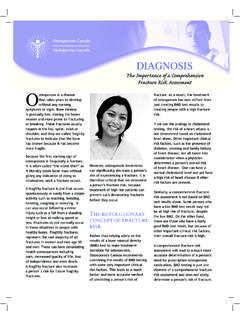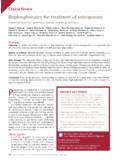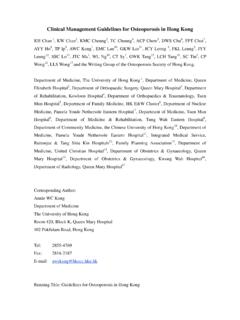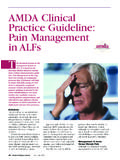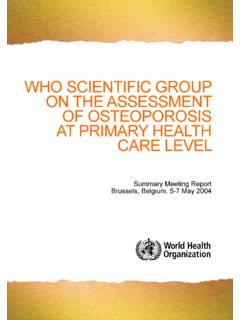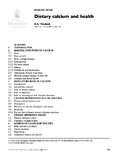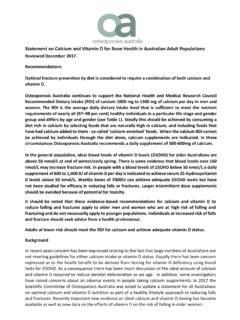Transcription of DRUG TREATMENTS - Osteoporosis Canada
1 Their role in fracture reduction and treatment of osteoporosisOsteoporosis leads to fragility fractures. These are broken bones that happen from a minor injury but that have major consequences such as pain, disability and sometimes death. Therefore, Osteoporosis Canada supports the use of medications that have been proven, in good clinical trials, to significantly reduce a person s risk of fracture. An individual s risk of fracture is determined by undergoing a comprehensive fracture risk assessment. This begins with a detailed discussion with your healthcare provider.
2 If you are found to be at risk of Osteoporosis or an Osteoporosis related fracture, you may need a bone mineral density (BMD) test, the results of which are then incorporated into one of the new fracture risk assessment tools CAROC or FRAX. This process allows your doctor to calculate your fracture risk. Fracture risk assessment is covered in detail in Osteoporosis Canada s Diagnosis fact sheet. Osteoporosis medications are strongly recommended for individuals who have a high fracture risk and generally not recommended for people who are at low risk of fracture.
3 Those who are at moderate risk may or may not need Osteoporosis medications. They should discuss the various options with their OUR BONES WORKBone is living tissue. It is constantly being repaired. As old bone is removed it is replaced by new bone. Cells called osteoclasts chew up the old bone (this is called resorption), creating small cavities; bone-forming cells called osteoblasts then fill in the cavities with new bone. This is nature s way of repairing bone and keeping it younger people with healthy bones, the osteoclasts and osteoblasts work together, in perfect balance.
4 However, after our mid 30s, this balance is shifted and we begin to gradually lose more bone than we replace. In someone with Osteoporosis , bone loss occurs to a much greater extent, causing the bones to become thinner and weaker over time, which increases the risk of fracture. FINDING THE MEDICATION THAT S RIGHT FOR YOUIf you are at high risk of fracture, you should review the various Osteoporosis drug treatment options with your physician, assessing the benefits and risks of each and choosing the best treatment for you.
5 Medications used to treat Osteoporosis fall into two broad groups: anti-resorptive medications slow down the work of the bone removing cells (osteoclasts); bone formation medications increase the work of the bone building cells (osteoblasts). Each individual is different. Your other health conditions and how you prefer to take medication will influence your decision about which drug to use. Some people respond better to one drug than another, or may have side effects on one drug and not another. Cost may be another consideration.
6 Provincial and private drug plans may not cover the cost of all available Osteoporosis medications. All of these factors will need to be considered before you make your final decision. The following brief descriptions of drug treatment options may help you discuss with your doctor the most appropriate treatment for are the most common family of drugs used to treat Osteoporosis . They are part of the group of Osteoporosis medications known as anti-resorptives. Four bisphosphonates are currently used for Osteoporosis in Canada : alendronate (Fosamax , Fosavance and generics), risedronate (Actonel , Actonel Plus Calcium, Actonel DR and generics), zoledronic acid (Aclasta ) and etidronate (Didrocal and generics).
7 HOW DO THEY WORK?Bisphosphonates bind to the surfaces of the bones and slow down the bone resorbing action of the osteoclasts. This alters the balance between the drug TREATMENTS osteoclasts and the osteoblasts such that bone loss is usually stopped and bone strength is improved. HOW EFFECTIVE ARE THEY?The most effective and preferred bisphosphonates are alendronate, risedronate and zoledronic acid because they reduce the risk of fractures in all bones (hip, spine and other areas). Etidronate is the oldest and least preferred bisphosphonate because it is not as effective as the other three bisphosphonates and only reduces the risk of fracture in the spine.
8 Individuals taking etidronate are encouraged to discuss with their doctor the option of switching to one of the other available CAN TAKE THEM?Bisphosphonates can be used to reduce the risk of fractures in postmenopausal women and men with Osteoporosis as well as in people who are on steroid medications such as ARE THEY TAKEN?There are very specific instructions about how bisphosphonates must be taken. Following the directions will allow your body to absorb the drug properly so that it works well and helps you avoid possible side effects.
9 Make sure you understand these instructions. With the exception of Actonel DR (delayed release), bisphosphonates should not be taken with food or at the same time as other vitamins, supplements or medications. If you need to take a calcium supplement, you should ensure that you wait at least one hour after taking your bisphosphonate. Calcium supplements are best taken with food. For more details, see the table on the right. ARE THERE SIDE EFFECTS?The most common side effect from the bisphosphonate pills is heart burn related to irritation of the esophagus.
10 There is a small risk of ulcers in the esophagus with both alendronate and risedronate, especially if taken incorrectly (if there is insufficient NameAlendronate (Fosa-max ) 10 mgAlendronate(Fosamax ) 70 mg (Fosavance )70 mg alendronate + 2800 IU or 5600 IU of vitamin DRisedronate (Actonel ) 5 mgRisedronate (Actonel ) 35 mgRisedronate(Actonel ) 150 mg(Actonel Plus Calcium) 35 mg risedronate + 500 mg elemental calciumRisedronate (Actonel DR ) 35 mgDR = delayed releaseZoledronic acid(Aclasta ) 5 mgEtidronate (Didrocal ))
